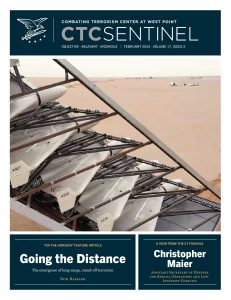From the Editor
Long-range aerial attacks by the Iran-backed Houthi terrorist group, including a ballistic missile that traveled at least a thousand miles toward Israel before being intercepted (reportedly in space) on October 31, 2023, are focusing minds on long-range stand-off terrorism. In this month’s feature article, which conceptualizes, outlines, and examines the implications of this emerging threat vector, Don Rassler argues that the notion that terrorists could strike the United States across the oceans with unmanned aircraft systems (UAS) is becoming increasingly less far-fetched.
Rassler writes that “over the coming decade, hydrogen fuel cell and solar UAS technology will evolve and mature, and will also likely become more available and accessible to the average consumer, which will make longer ranges more accessible as well. Other disruptive technologies, such as generative artificial intelligence, will also mature and will likely be used by extremists to help them optimize system performance and to overcome, or devise creative solutions to, technical long-range UAS challenges.” He warns that “long-range stand-off terrorism will be attractive to some extremists because it opens-up new attack pathways, can enable surprise, and has the potential to deliver a potent psychological, ‘we can strike you from afar’ punch. Over the next decade advancements in commercial technologies and systems will also make range, and extended range, more accessible for violent non-state-entities, making it likely that in the future long-range terrorism will become even more of a threat.” Rassler’s article is the first in a new recurring series in CTC Sentinel entitled “On the Horizon” that will examine emerging counterterrorism challenges.
Our interview is with Christopher Maier, the Assistant Secretary of Defense for Special Operations and Low-Intensity Conflict. “We need to have sustainable CT operations that prevent terrorists’ actions, principally al-Qa`ida and ISIS, to ensure we are not distracted by what we view as the longer-term strategic priorities, such as peer adversaries,” he says. “As the rest of the Department and other parts of the U.S. government are doing less CT, [this] means that those who are doing it have to do it better and, in many respects, do it more proportionally to the rest of the national security enterprise. This is why SOF is looked to as the lead for the CT fight in the Department.”
Daisy Muibu examines the state of Somalia’s military campaign against al-Shabaab. She writes that: “A year and five months after the Somali government launched its offensive against al-Shabaab, the initial optimism that characterized its first few months have diminished as the counterinsurgency’s momentum has stalled in the central regions of the country.” She adds that “with only a year left until African Union forces are mandated to fully draw down, significant obstacles remain that cast doubts over the government’s ambitious goals to defeat al-Shabaab and assume full responsibility for securing the country by December 31, 2024.”
Paul Cruickshank, Editor in Chief
 Skip to content
Skip to content

